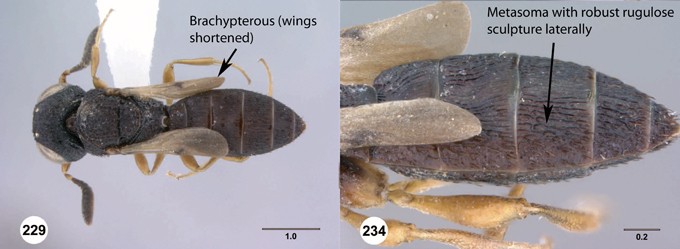
1. Brachypterous (Fig. 229); metasoma with robust
rugulose sculpture laterally (Fig. 234) ... Scelio memorabilis

─ Macropterous (Fig. 145); metasoma with moderately developed striate to
reticulate-rugulose sculpture laterally (Fig. 150) ... 2

2. Base of metasoma yellow to light brown, then darkening to brown
toward apex (Fig. 145); coxae yellow; ventral
margin of villus straight (Fig. 148); (pilosity of gena sparse to
moderate; smaller individuals, Kenya) ... Scelio ululo
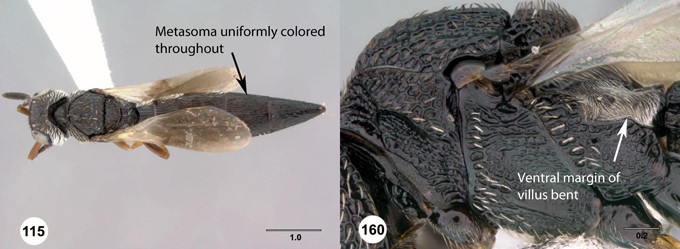
─ Metasoma uniformly colored throughout, never yellow
(Fig. 115); coxae light brown
to brown, {never?} yellow; ventral margin of
villus variously formed, but more commonly concave, bent, or angled (Fig. 160) ... 3

3. Metasoma elongate, wings not reaching T5 (Figs 115, 157) (large
individuals) ... 4

─ Metasoma not elongate, wings typically meeting or surpassing anterior
margin of T5 (Figs. 217, 235) ... 5

4. Ventral margin of villus straight (Fig. 118); frons below anterior
ocellus with pilosity white (Fig. 119); gena with dense
white pilosity (Fig. 118) (Gabon) ... Scelio fremo
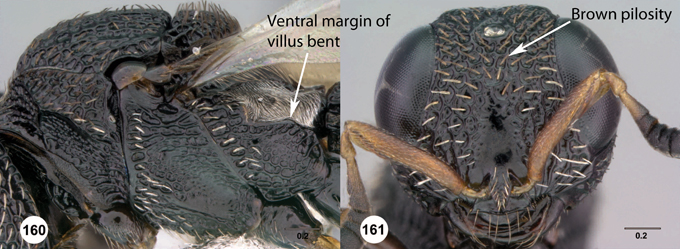
─ Ventral margin of villus bent medially (Fig. 160); frons below
anterior ocellus with some brown pilosity (Fig. 161);
gena moderately setose with off-white to golden brown pilosity (D.R.
Congo) ... Scelio balo
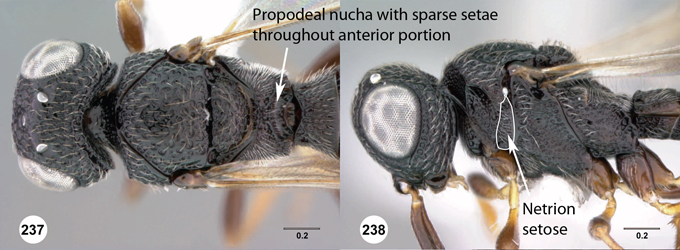
5. Propodeal nucha with sparse setae
throughout anterior portion (Fig. 237); netrion setose (Fig. 238) ... 6

─ Propodeal nucha glabrous (Fig. 219); netrion
glabrous (Fig. 220) ... 7
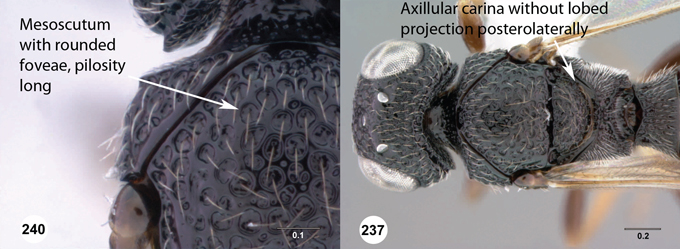
6. Mesoscutum predominantly sculptured with rounded foveae, pilosity
arising from foveae long, extending into other cells (Fig. 240); axillular carina moderately developed, not forming lobed
projection posterolaterally ... Scelio philippinensis

─ Mesoscutum predominantly coarsely rugulose to reticulate, pilosity
very short (Fig. 165); axillular carina very well
developed, extended posterolaterally into lobed projection (Fig. 168) (gena
in lateral view narrow, with genal carina
irregularly developed; mandibles narrow, Fig. 167) ... Scelio bubulo

7. Mesoscutal sculpture consisting predominantly of rounded punctures on
an otherwise smooth surface, pilosity arising
from punctures very short (Fig. 222); felt fields present on S2, S3 and
S4 (Fig. 218); laterotergites minutely aciculate (Madagascar) ...
Scelio effervesco
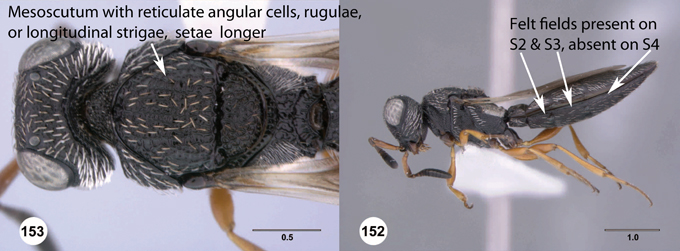
─ Mesoscutal sculpture consisting predominantly of reticulate angular
cells, rugulae, or longitudinal strigae, cells not
particularly rounded, setae generally longer and more prominent (Fig.
153); felt
fields present on S2 and S3, absent on S4 (Fig. 152); laterotergites smooth or sculptured ... 8

8. Pilosity of frons below anterior ocellus white (Fig. 155); pronotal shoulder predominantly covered with
white setae, with at most several brown setae adjacent margin with
mesoscutum, setae often slightly lighter than that of
mesoscutum (Fig. 29); pilosity of pronotal shoulder
usually thick, white, and somewhat truncate at at tips
(Fig. 29) ... 9

─ Pilosity of frons below anterior ocellus golden brown to brown (Fig. 209); pronotal shoulder with
some, often all, setae brown (Fig. 30),
setae usually concolorous with those of mesoscutum;
thickness and length of pronotal shoulder pilosity variable but
sometimes narrower and shorter (Fig. 30) ... 14

9. Villus somewhat compact, with ventral margin straight and dorsal
margin parallel (Figs 14, 154); pilosity of dorsal
head white to very light yellow; gena with dense pilosity at narrowest
point in lateral view (Fig. 156); scape and legs
usually yellow, in some with slight light brown infuscation ... Scelio
zolotarevskyi
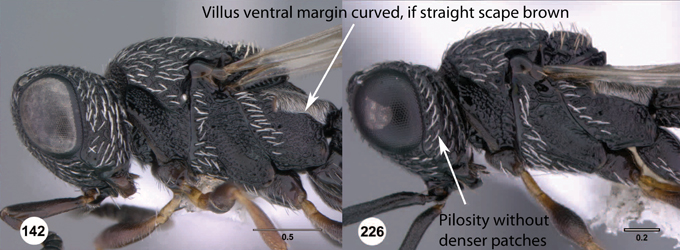
─ Villus variously formed, in most with ventral margin curved or angled,
if straight or nearly so then scape brown to dark
brown throughout; pilosity of the dorsal head variously colored, but
usually golden to light brown; gena with pilosity more
or less uniformly distributed throughout, without denser patches; color
of scape and legs variable, but hind femur often with
brown infuscation medially ... 10

10. Robust, large (5.04–5.91 mm); dark-brown to nearly black individuals
(Figs 139, 140); pilosity of head and
mesoscutum completely white, on mesoscutellum off-white, yellowish; T2
laterally with dense white patch of thickened
setae (Fig. 144); upper anterior margin of metapleuron with two rows or
a slightly broader patch of white setae (Fig.
142); scape dark brown; mesopleural depression with a small smooth
patch near mid coxa (Fig. 142) (Madagascar) ...
Scelio scomma

─ Size varying, but typically smaller than 5 mm; color varying, but
often with metasoma brown and slightly lighter in color
than mesosoma; color of pilosity of head and mesonotum varying, but for
those in continental Africa usually golden brown
on dorsal surfaces; pilosity of T2 sparse to dense; pilosity of upper
anterior edge of metapleuron variable, but often only a
single row of setae present; scape variously colored but usually not
dark brown; mesopleural depression variously
sculptured, with or without smooth patches ... 11
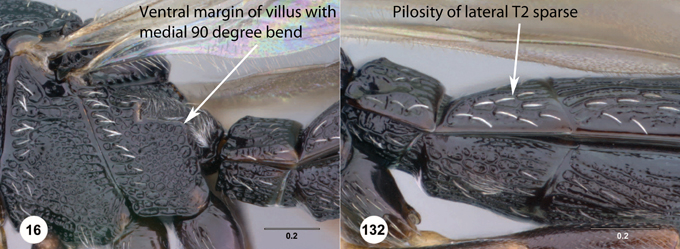
11. Villus with ventral margin in posterior half bent downwards forming
a medial angle (Fig. 16); gena appearing sparsely
setose due to somewhat shortened setae that only slightly overlap
adjacent cells; pilosity of lateral T2 sparse (Fig. 132);
scape brown (lateral T2 usually with reticulate cells surrounding setae;
smaller individuals (Madagascar) ... Scelio igland
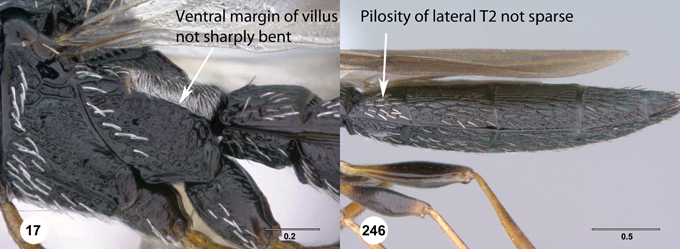
─ Shape of villus variable, ventral margin typically not as sharply bent
medially, but rather slightly concave (Fig. 17); pilosity of gena
in lateral view varying in density and length; scape color varying,
yellow to brown; pilosity of lateral T2 varying (Fig. 246)
(continental Africa) ... 12

12. Pilosity of lateral T3–T5 predominantly brown; scape completely
brown to dark brown, more or less concolorous with
flagellum (Fig. 228); S3 felt field narrow to absent;
sculpture of the frons robustly reticulate (Fig. 227), reticulations nearly meeting malar sulcus (i.e. facial striae
very short to absent) (mesonotum somewhat flattened; eye bulging towards
anterodorsal corner (Fig. 226); clava somewhat elongate
in most (Fig. 228) ... 13

─ Pilosity of lateral T3–T5 predominantly white
(Fig. 126); scape lighter at base
(yellow to light brown) to brown at apex, lighter in
color than flagellum; S3 felt field well developed; sculpture of frons
variable, though almost never uniformly strongly
reticulate throughout, facial striae generally longer (Fig. 125);
mesonotum rounder (Fig. 124) ...
Scelio howardi
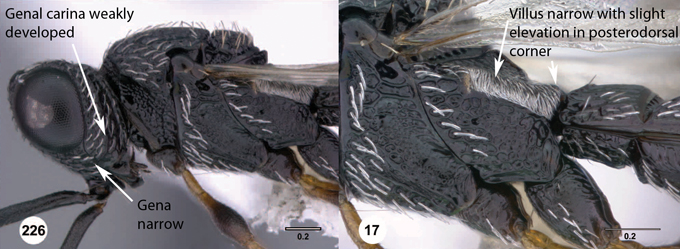
13. Gena narrow, with genal carina weakly developed but discernible
(Fig. 226); T3–T5 with a sparse row of white setae
along ventrolateral margin; S3 felt field extremely reduced to absent;
villus relatively long and narrow, with concave lower
margin, usually with slight elevation in posterodorsal corner (Fig.
17); size 3.75–4.34 mm (frons slightly concave to flat) ...
Scelio destico
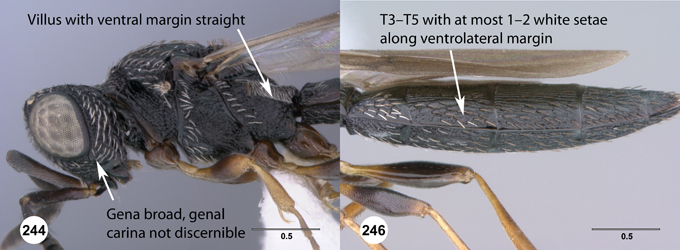
─ Gena broad, genal carina not discernible (Fig. 244); T3–T5 with at
most 1–2 white setae along ventrolateral margin (Fig. 246); S3
felt field reduced, but never absent; villus with ventral margin
straight or extremely slightly curved; size 4.64–5.52 mm ...
Scelio pipilo
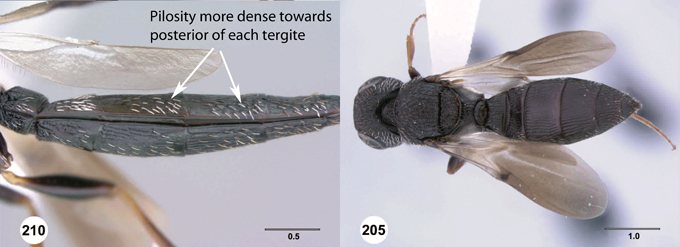
14. Pilosity of lateral metasoma more dense towards posterior of each
tergite (Fig. 210); frequently with both brown and
white setae on a single tergite (Fig. 205) ... Scelio susurro
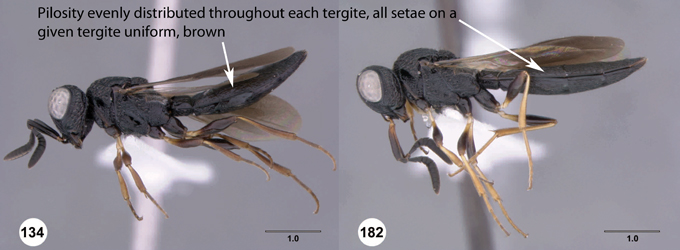
─ Pilosity of lateral metasoma evenly distributed throughout each
tergite, all setae on a given tergite uniform, brown, short
and narrow (Figs. 134, 182) (one exceptional specimen from Madagascar with white setae on
lateral T2 but otherwise similar) ... 15

15. Sculpture of mesonotum somewhat flat and thick, irregularly
obliterated in humeral area (Fig. 135); course of notauli
clearly indicated, medial margin thick and in larger individuals with
scattered micropunctures (Fig. 138, nt); pronotal
nucha predominantly smooth excluding setigerous punctures; mesopleural
depression predominantly smooth (Fig. 136)
(Madagascar) ... Scelio ructo

─ Sculpture of mesoscutum varying, but typically not flat and thick,
sculpture of humeral area uniform without obliterated
patches (Fig. 183); notauli variously indicated, but generally without inner course
of notaulus thickened, micropunctures very sparse if
present at all; pronotal nuchal smooth or sculptured; mesopleural
depression with at most a very small smooth patch (Fig. 184) ... 16
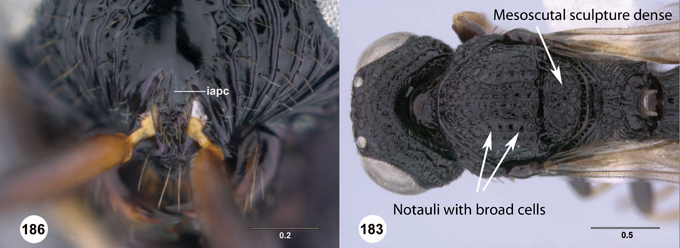
16. Interantennal process with a well-developed carina medially (Fig.
186, iapc); course of notauli clearly visible, divided
more or less evenly into broad cells (Fig. 183); sculpture of
mesoscutum thick, reticulate (Uganda) ... Scelio gemo
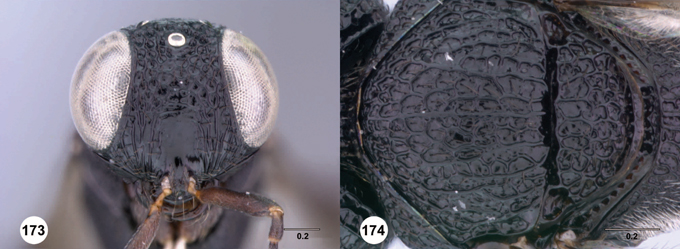
─ Interantennal process with surface uninterrupted medially, smooth
(Fig. 173);
course of notauli indicated or not; sculpture of the
mesoscutum variously formed (fig. 174) ... 17

17. Posteromedial head rounded such that occipital carina obliterated or
obscured by similar sized rugae, in most cases a
single carina not traceable throughout (Fig. 195); T6 sculpture fine parallel
longitudinal striae with few reticulations immediately
adjacent to apical margin (Fig. 193); hind tibia yellow; pilosity of pronotal
shoulder slightly lighter colored than that of mesoscutum
(Fig. 26); laterotergites with at least some aciculate sculpture
(Tanzania, Malawi, D.R. Congo) ... Scelio latro

─ Posteromedial head relatively abruptly sloped beyond occipital carina,
occipital carina percurrent or at most minutely
interrupted medially (Fig. 177); T6 sculpture variable, rugulose to reticulate,
rarely with finer longitudinal elements (Fig. 175); hind tibia yellow
or yellow and brown; pilosity of pronotal shoulder usually concolorous
with that of mesoscutum (Fig. 30); laterotergites
smooth or aciculately sculptured ... 18

18. Hind tibia completely yellow, without trace of infuscation or brown
bands (Fig. 176); notauli clearly visible posteriorly, a smooth
channel without divisions, anteriorly irregularly confused (Fig. 177);
sculpture of mesoscutum fine, somewhat more
longitudinal than reticulate (Fig. 177); T6 with transverse rugae that
are only sparsely reticulate (Fig. 180) (Tanzania) ...
Scelio crepo

─ Hind tibia with at least some brown coloration
(Fig. 188); notauli variously
formed; sculpture of mesoscutum variable, but generally more robust
(Fig. 189); T6 rugulose reticulate (Fig. 192) ... 19
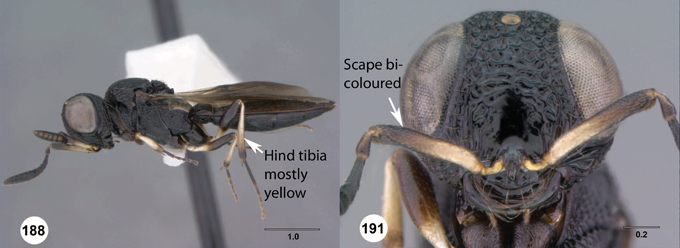
19. Hind tibia yellow with a short brown band at apex
(Fig. 188), or light brown
throughout; scape color a gradient, yellow to light
brown at base, brown at apex (Fig. 191) ... 20

─ Hind tibia with basal half yellow, apical half brown
(Fig. 170); scape evenly
brown to dark brown throughout (Fig. 173) (axillula well
developed) ... 21
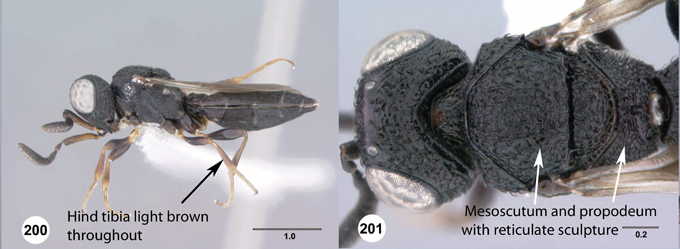
20. Hind tibia light brown throughout, without darker apex; mesoscutum
and propodeum with reticulate sculpture (Fig.
201) laterotergites smooth or nearly so; margin of metasomal sternites
sculptured throughout with fine reticulate
microsculpture; size 3.20–3.93 mm (South Africa) ... Scelio mutio

─ Hind tibia yellow with a short brown band at apex (see Comments); mesoscutum and propodeum with thick percurrent
longitudinal carinae that form more or less smooth channels with few
interrupting transverse elements (Fig. 189);
laterotergites with aciculate sculpture, usually throughout; margin of
metasomal sternites smooth to very slightly irregular;
size 4.69–5.16 mm (Ghana, Guinea, D.R.C) ... Scelio grunnio
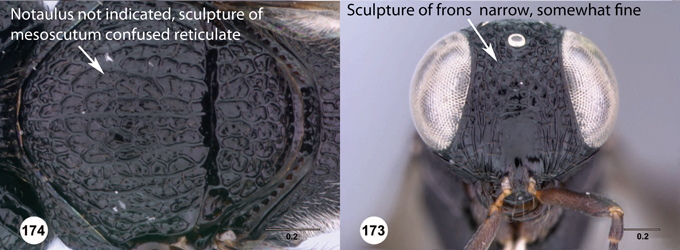
21. Notaulus not clearly indicated, sculpture of mesoscutum confused
reticulate (Fig. 174); sculpture of mesonotum and
frons (Fig. 173) narrow, somewhat fine; longitudinal carina at base of
T2 truncated near base by smooth patches, not
continuing more or less throughout length of T2; axillula developed, but
not strongly elevated above dorsal surface of
mesoscutellum posterolaterally (anterodorsal oblique view) (Uganda) ...
Scelio cano
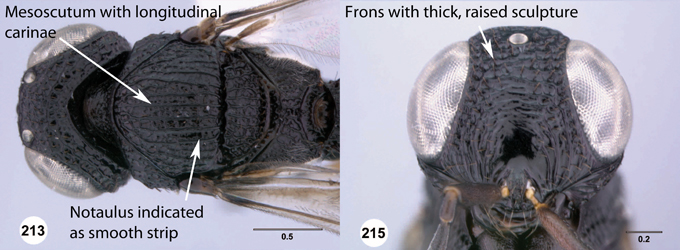
─ Notaulus indicated posteriorly as smooth strip, sometimes with few
irregular carina interrupting its course, not clearly
indicated anteriorly (Fig. 213); sculpture of mesoscutum with distinct percurrent
longitudinal carinae (Fig. 213); frons with thick, raised sculpture
(Fig. 215); anteriormost longitudinal
carinae of T2 not truncated by smooth patches near base of T2, more or
less percurrent throughout T2; axillula well
developed, elevated above dorsal surface of mesoscutellum
posterolaterally (Cameroon, Central African Republic) ... Scelio
tono
|